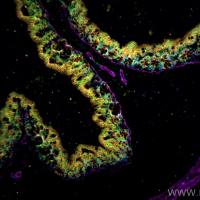Quantitative Measurement of Phosphopeptides and Proteins via Stable Isotope Labeling in Arabidopsis and Functional Phosphoproteomic Strategies
互联网
511
Protein phosphorylation is one type of posttranslational modification, which regulates a large number of cellular processes in plant cells. As an emerging powerful biotechnology that integrates all aspects of advantages from mass spectrometry, bioinformatics, and genomics, phosphoproteomics offers us an unprecedented high-throughput methodology with high sensitivity and dashing speed in identifying a large complement of phosphoproteins from plant cells within a relatively short period of time. Needless to say, phosphoproteomics has become an integral portion of life sciences, which penetrates various research disciplines of biology, agriculture, and forestry and irreversibly changes the way by which plant scientists study biological problems.Because phosphorylation/dephosphorylation of protein is dynamic in cells and the amount of phosphoproteins is low, the preservation of a phosphor group onto phosphosite throughout protein purification as well as enrichment of these phosphoproteins during purification has become a serious technical issue. To overcome difficulties commonly associated with phosphoprotein isolation, phosphopeptides’ enrichment, and mass spectrometry analysis, we have developed a urea-based phosphoprotein purification protocol for plants, which instantly denatures plant proteins once the total cell content comes into contact with the UEB solution. To measure the alteration of phosphorylation on a phosphosite using mass spectrometer, an in vivo 15 N metabolic labeling method (SILIA, i.e., stable isotope labeling in Arabidopsis ) has been developed and applied for Arabidopsis differential phosphoproteomics. Thus far, hundreds of signaling-specific phosphoproteins have been identified using both label-free and 15 N-labeled differential phosphoproteomic approach. The phosphoproteomics has allowed us to identify a number of signaling components mediating plant cell signaling in Arabidopsis . It is envisaged that a huge number of phosphosites will continue to be uncovered from phosphoproteomics in the near future, which will become instrumental for the development of plant phosphor-relay networks and molecular systems biology.









